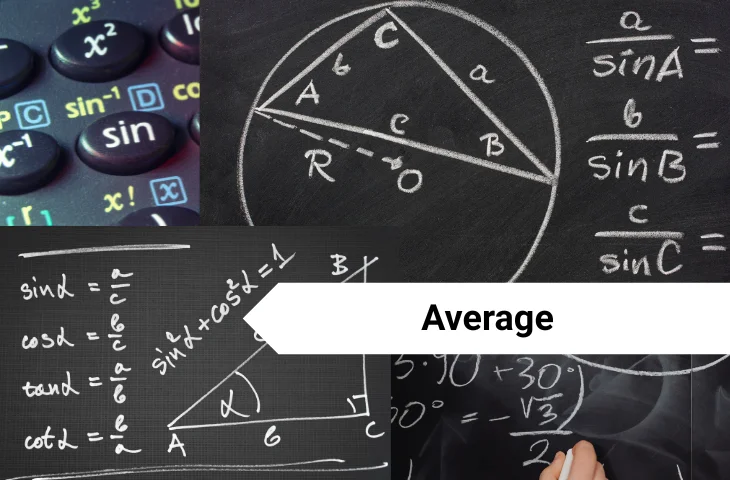The topic Average is one of the most basic yet highly scoring chapters in Quantitative Aptitude. Whether you are preparing for SSC, Banking, RRB, or State-level exams, you will definitely face 1–2 questions on averages. In this blog, we have provided all the details about the importance of average, types of questions asked, short notes, formulas, Solved questions from 2024–25 exams, and more.
What Is Average in Quantitative Aptitude?
In Quantitative Aptitude, Average represents the central value of a group of numbers. It is calculated by dividing the sum of values by the number of values.

Why it appears in exams?
- It checks a candidate’s ability to deal with arithmetic, ratios, and logical distribution.
- Average-based questions often link with other topics like speed, time, age, and mixture.
Skills required to solve quickly:
- Quick calculation skills
- Logical substitution
- Pattern recognition
Why Is Average Important in Competitive Exams?
Average is a repeat-topic in almost all competitive exams. It looks simple but examiners often mix it with other chapters to increase difficulty.
| Exam | No. of Questions | Difficulty |
| SSC CGL / CHSL | 1–2 | Easy |
| IBPS PO / SBI PO | 1–2 | Moderate |
| RRB NTPC / Group D | 1 | Easy |
| State PSC / Police | 1–2 | Moderate |
Average Quantitative Aptitude Short Notes
Here’s a quick summary of must-know concepts related to Averages:

Attempt the SSC CGL Previous Year Paper Now and Check Your All-India Rank Today!
Quick Revision Summary
Some quick revision summary notes for final preparation before the exam are as follows:

What Are the Types of Average Questions in Quantitative Aptitude?
In exams, average-based questions can appear in different forms:
- Direct: Simple average of given numbers
- Puzzle-based: Average of groups with missing terms
- Application-based: Averages in ages, cricket scores, or salaries
- Mixed-concept: Average with speed, time, mixture, or percentages
Attempt SBI PO Mains Mock Test Today!
Average Formulas for Quantitative Aptitude
To save time, remember these formulas:

Attempt the SBI PO Previous Year Paper Now and Check Your All-India Rank Today!
Average Tricks for SSC CGL and Other Exams
To solve questions faster:
- Avoid writing full steps – use mental math.
- For consecutive numbers, average = middle term.
- In cricket score problems, use difference rule instead of recalculating.
- For weighted averages, use alligation method.
- When speed is involved, check if distance is equal – apply harmonic mean formula.
Solved Average Questions from 2024–25 Exams
Here are some latest memory-based and mock-sourced examples:
Q1. (SSC CGL 2024 Tier 1 – Memory Based)
The average of 5 numbers is 28. If one number is excluded, the average becomes 26. Find the excluded number.
Solution:
Sum of 5 numbers = 28 × 5 = 140
Sum of 4 numbers = 26 × 4 = 104
Excluded number = 140 – 104 = 36
Q2. (IBPS PO Prelims 2024)
The average score of 40 students is 55. If teacher’s marks (70) are added, what is the new average?
Solution:
Total = 40 × 55 = 2200
New total = 2200 + 70 = 2270
New average = 2270 ÷ 41 = 55.37
Q3. (RRB NTPC 2024 Shift 2 – Memory Based)
Find the average of first 10 odd numbers.
Solution:
Formula = n = 10
Answer = 10
Check out the Upcoming Government Exam Notification Today!
Average Concepts for Bank Exams
In IBPS/SBI exams, average is often twisted with coded data or DI sets. For example:
Example: The average marks of A, B, and C is 60. If A’s marks are 10 more than B, and C’s marks are 10 more than A, find B’s marks.
Solution:
Let B = x, A = x+10, C = x+20
(x+(x+10)+(x+20))÷3=60(x + (x+10) + (x+20)) ÷ 3 = 60(x+(x+10)+(x+20))÷3=60
⇒ (3x + 30) ÷ 3 = 60
⇒ x + 10 = 60
⇒ x = 50
Common Mistakes to Avoid while Solving Average Questions
Some of the common mistakes that aspirants must avoid while solving average questions are as follows:
- Forgetting number of terms – Always check count before dividing.
- Misapplying average speed formula – Works only when distance is equal.
- Mixing up weighted average and simple average – Identify correctly.
- Not updating total when adding/removing values – Recalculate sum properly.
- Rounding too early – Keep exact values until the final step.
Related Quantitative Aptitude Topics to Explore
FAQs
Use direct formulas like middle term rule or difference rule.
Yes, average forms the base of alligation method.
Yes, often in pie chart and table DI.
New average = Old average ± Difference ÷ No. of terms.
Average = (First + Last)/2.
- PNB LBO Syllabus and Exam Pattern 2025, Check Details
- PNB LBO Salary 2025, In Hand Salary, Perks, and Allowances
- Most Repeated Quantitative Aptitude Questions for SSC CHSL Tier 2
- Bank of Baroda LBO Group Discussion, Topic List, Complete Guide
- Bank of Baroda LBO LPT, State-wise Languages & Full Details
- Bank of Baroda LBO Interview Questions and Answers, Download FREE PDF

Hi, I’m Aditi. I work as a Content Writer at Oliveboard, where I have been simplifying exam-related content for the past 4 years. I create clear and easy-to-understand guides for JAIIB, CAIIB, and UGC exams. My work includes breaking down notifications, admit cards, and exam updates, as well as preparing study plans and subject-wise strategies.
My goal is to support working professionals in managing their exam preparation alongside a full-time job and to help them achieve career growth.
